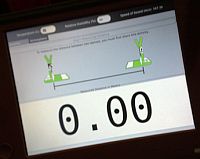For Real Learning, Mobility and Saturation Matter
In September 2007, while I was still working at One Laptop per Child (OLPC), I debated with Stephen Dukker, co-founder of NComputing on the topic, “Will Low-Cost Laptops Help Kids in Developing Countries?” and Dukker made what I thought was the seminal point when he said:
“OLPC’s key development in our view is the software – who cares about the hardware as long as it gets the job done inexpensively?”
Nonetheless, it is still worthwhile discussing the advantages (and disadvantages) of various hardware approaches to deploying learning software such as the Sugar Learning Platform. I am ignorant of the current total-cost-of-ownership of the various options available; I leave this complex calculation to Mark Beckford and assume that he will take into consideration not just the lifetime cost of the hardware, but also training, administration, maintenance and repair, energy and disposal costs.
Other important factors, not often considered, include where the cost is born and to whom the investment brings benefit. For example, can support be delegated to enterprising high-school students (or some other local community resource) or must it be outsourced (out of district or even out of the country)? All other factors being equal, it matters where you make the investment.
What I will discuss here is “reach” in terms of who is learning, what is learned, and how it is learned. If we set our sights higher than using the computer to access information and learn “21st century computer skills”, the choice of model needs to be taken into consideration.
Of course, the principle advantage of a saturated model of computing is that the computer is available to every child at all times. In a middle school in Massachusetts, the children use their laptops to write in every class, including music, dance, and gym.
The children learn computer skills, but they also learn to use computation to enhance other curricula goals, through demonstrations, projects, and critiques. Learners develop craft, engage and persist, envision, express, observe, reflect, stretch and explore, and understand. Computation is used as a critical-thinking tool in the context of open-ended exploration and discovery, going beyond the use of the computer as a tool of instruction.
It is often the stated goal of one-to-one computer programs that laptops go home with the children. This is desired in that not only does child ownership result in less breakage – statistics from the Maine laptop program bear this out – but also, the computer, which otherwise was only available at school is now available to the entire family.
A study done by Claudia Urrea in Costa Rica found that the majority of parents use the computer at home for their own learning – a further leveraging of the investment. Other programs, where it is infeasible to let the children travel between school and home with a computer, have instituted “technology goes home” programs – a subsidy to parents to purchase new or used equipment to have in the home. The goals of such programs have been to bridge learning from school into the home and to engage parents and siblings in the school community and in their own learning.
Mobility and form factor also play a role. In a trip to rural Thailand, I got to see first hand how netbooks were being used to change what is learned and how it is learned. Two examples really resonated with me. In one example, the children organized a orchestra in which they combined computer music with the traditional instruments of their village. They sat on the floor with their parents, performing together.
Here, the form factor of a netbook computer was an enabling element to their physically being able to interweave the new and the old into a community and musical synthesis. In a second example, the children took their netbooks into the forest to capture the sights and sounds of their habitat. In some schools, students attach sensors to their netbooks so as to capture data such as temperature “in vivo”. Back in the classroom, they process these raw data as part of their science curriculum.
Mobility has also played a role in extra curricular activities. For example, an elementary-school student established an after-school photography business in a community for Afghani refugees in Pakistan, using a netbook.
But the most dramatic example is one that Benjamin M. Schwartz recently brought to my attention. Ben is the author of the Distance Activity, which measures the distance between two OLPC XO-1 computers through a measurement of sound-wave prorogation. It is incredibly engaging and has been used in a wide variety of situations, including gym class, where it has be used to introduce measurement and calculation to activities usually not considered academic.
Ben recently blogged about Stephanie Selvick’s experience with the use of Distance in a school in Senegal. A previously skeptical teacher enthusiastically began to brainstorm about connections to traditional curricula goals, such as “assignments for his kids to measure the distance around their homes or rooms” and to “figure out area from those numbers.”
As was reported from Senegal, “The goal of making teachers the experts for each other felt underway.” Opening the door to teachers to engage in learning “constructively” is of tremendous value.
Opening their eyes to the fact that they have ideas to contribute and that the software and hardware are able to be shaped to meet their needs is hard to put a price on, but also should be a factor in estimating the cost of deployment. While such “awakenings” could take place in a school computer lab, they are much more likely to occur when computation is always at hand, as part of everyday life.
I have largely avoided discussing the saturation vs. shared-use dichotomy. The same software, e.g. Sugar, can be used in both configurations. I echo Dukker in being supportive of whatever means we can deploy to get great software into the hands of children, inexpensively. However, we should not lose sight of the benefits afforded by the form factor and mobility of the netbook computer.
“21st century computer skills” seem to be about the acquisition of some specific knowledge – necessary but not sufficient. Learning is about the acquisition of a new “outlook” – what we are capable of doing with that knowledge .



I think the example from Stephine is telling – the teachers were able to incorporate computers into educational settings only when they themselves were familiar with the technology and its promise. I feel this is a key requirement for any successful deployment of computers in schools.
Do you think teacher experimentation and exploration can occur in a lab setting? Or should technologists promote a teacher's laptop/netbook as key to any education-based installation?
South Africa actually has a teacher's laptop program. Aside: It prohibits teachers from choosing open source.
They can run Sugar on a Stick without making any "unauthorized" changes to their proprietary software (See http://wiki.sugarlabs.org/go/Sugar_on_a_Stick).
Ben just released Distance v16, which includes an improved calibration feature that lets it run on non-OLPC-XO-1 hardware (Download it from http://dev.laptop.org/~bemasc/Distance-16.xo).
Walter,
I believe (as you well know) that cost is one of the largest barriers to adoption, just after plain inertia & fear of change. And often costs are seen in a per-student basis. Yet, with the Costa Rica example, you've just pointed out that when students can take home the educational device, parents are often co-learners with their children. Might you have an opinion on how education leaders should change their mindset around costs based on this? Maybe divide costs by student + 1 parent & 1 sibling?
Just for clarifications sake: the Distance example was from OLPCorps training in Kigali, Rwanda and not from my deployment in Senegal.